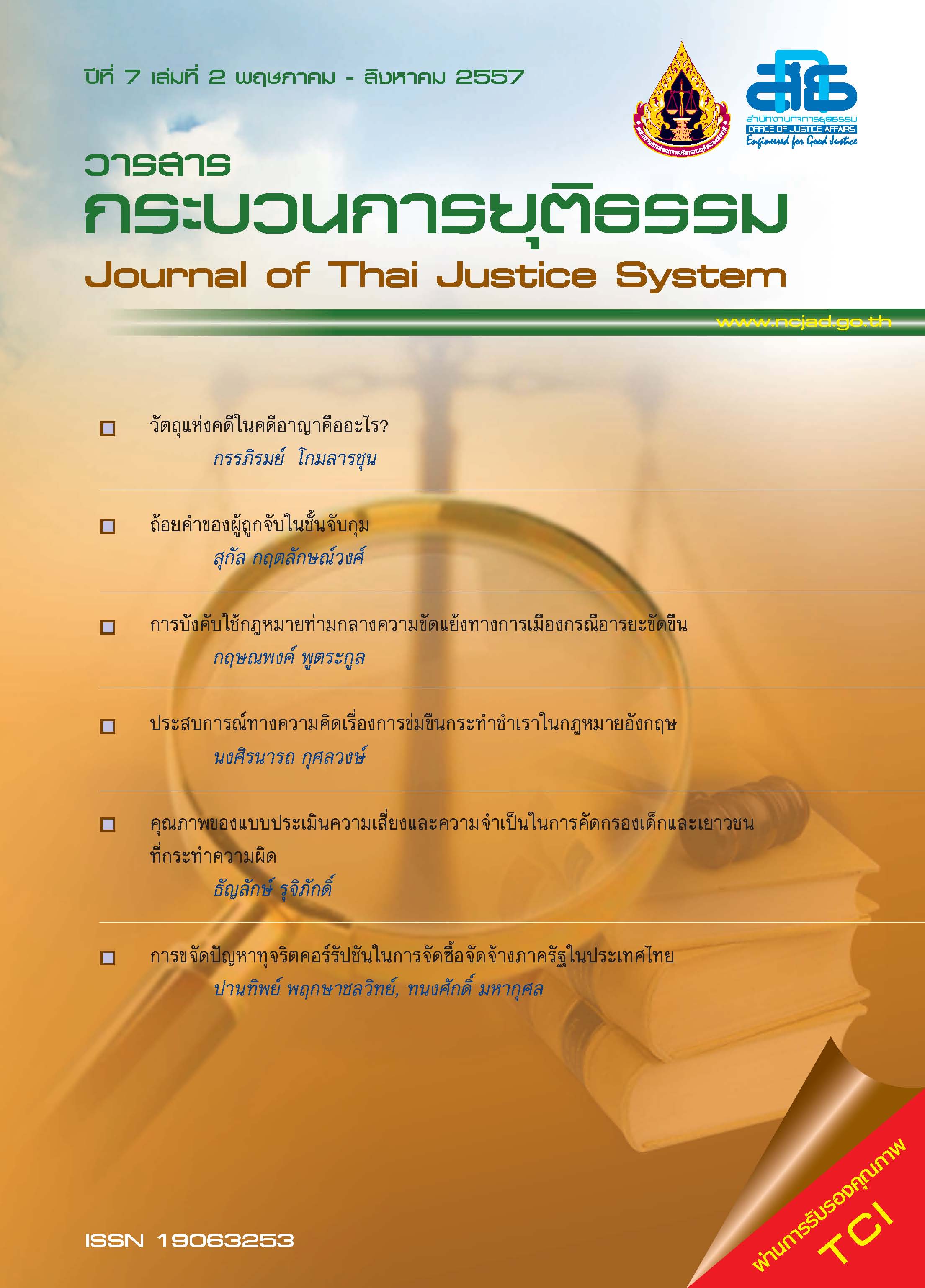คุณภาพของแบบประเมินความเสี่ยงและความจำเป็นในการคัดกรองเด็กและเยาวชนที่กระทำความผิด
Main Article Content
บทคัดย่อ
รายงานการวิจัยนี้มีวัตถุประสงค์เพื่อทดสอบคุณภาพของแบบประเมินความเสี่ยงในการกระทำผิดซ้ำและความจำเป็นในการบำบัดฟื้นฟูของเด็กและเยาวชนที่กระทำความผิด โดยการทดสอบค่าอำนาจจำแนก ความตรงตามสภาพ ความตรงเชิงทำนาย และความเที่ยงของแบบประเมิน การศึกษาครั้งนี้ใช้ระเบียบวิธีวิจัยเชิงปริมาณ กลุ่มตัวอย่างในการศึกษาครั้งนี้ ได้แก่เด็กและเยาวชนจำนวนทั้งหมด 1,181 ราย การทดสอบคุณภาพของเครื่องมือประเมินความเสี่ยงและความจำเป็นโดยใช้สถิติในการวิเคราะห์ข้อมูลการตรวจสอบค่าอำนาจจำแนกพบว่า ค่าอำนาจจำแนกรายข้ออยู๋ในระดับต้องปรับปรุงจนถึงดี ซึ่งสามารถแยกกลุ่มเด็กและเยาวชนได้ ผลการทดสอบความตรงตามสภาพ พบว่าเด็กและเยาวชนในกลุ่มความเสี่ยง และกลุ่มความรุนแรง มีความแตกต่างกันในปัจจัยด้านต่างๆ ทั้งการประเมินด้านความเสี่ยงและการประเมินด้านความจำเป็นอย่างมีนัยสำคัญทางสถิติที่ระดับ 0.05 ยกเว้น ปัจจัยด้านสถาวะกายและจิต ปัจจัยด้านปัญหาพฤติกรรม และปัจจัยด้านการคุ้มครองสวัสดิภาพเด็ก แสดงให้เห็นว่าแบบประเมินนั้นมีความตรงตามสภาพในระดับปานกลาง ส่วนการประเมินความตรงเชิงทำนายพบว่า ค่าความสัมพันธ์ระหว่างปัจจัยด้านต่างๆ ของคะแนนความเสี่ยงและ ความจำเป็นมีความสัมพันธ์กันอย่างมีนัยสำคัญทางสถิติที่ระดับ 0.05 และไม่มีความสัมพันธ์คู่ใดมีความสัมพันธ์กันสูงกว่า 0.80 ซึ่งแสดงให้เห็นว่าปัจจัยด้านต่างๆ นั้นวัดในสิ่งที่แตกต่างกันอย่างเห็นได้ชัด นอกจากนี้ จากการทดสอบค่าความสามารถในการทำนายการแบ่งกลุ่มของเด็กจากปัจจัยด้านต่างๆ พบว่าค่าความสามารถในการทำนายอยู่ในระดับปานกลางถึงดี คือมีค่าตั้งแต่ ร้อยละ 62 ถึง ร้อยละ 0.62 ซึ่งอยู่ในระดับที่สามารถยอมรับจากการทดสอบแสดงให้เห็นว่าแบบประเมินความเสี่ยงและความจำเป็นมีประสิทธิภาพในระดับดี สามารถจำแนกกลุ่มเด็กและเยาวชนได้ในระดับที่ยอมรับได้ แม้ว่าบางข้อมีค่าอำนาจจำแนกต่ำ อย่งไรก็ตามข้อคำถามที่ไม่สามารถจำแนกกลุ่มเด็กและเยาวชนได้ หน่วยงานที่เกี่ยวข้องจะทำการปรับเนื้อหาและค่าการให้คะแนนอีกครั้งหนึ่งเพื่อความเหมาะสมต่อไป
Article Details
ต้นฉบับที่ได้รับการตีพิมพ์ในวารสาร เป็นลิขสิทธิ์ของวารสารกระบวนการยุติธรรม แต่ความคิดเห็นที่ปรากฏในเนื้อหาของบทความในวารสารกระบวนการยุติธรรม ถือเป็นความรับผิดชอบของผู้เขียนแต่เพียงผู้เดียว
References
ณัฐวุฒิ อรินทร์. (2553). รายงานการศึกษาติดตามผลการประเมินความเสี่ยงต่อการเกิดพฤติกรรมรุนแรง ของผู้ป่วยนิติเวชหลังการจำหน่าย (รายงานการวิจัย). สถาบันกัลยาณ์ราชนครินทร์ กรมสุขภาพจิต.
บุญธรรม กิจปรีดาบริสุทธิ์. (2553). คู่มือการวิจัย การเขียนรายงาน การวิจัยและวิทยานิพนธ์. กรุงเทพฯ: โรงพิมพ์เรือนแก้ว.
บุญธรรม กิจปรีดาบริสุทธิ์. (2553). เทคนิคการสร้างเครื่องมือรวบรวมข้อมูลสำหรับการวิจัยกรุงเทพฯ: ศรีอนันตร์การพิมพ์.
ปัญญา ธีระวิทยเลิศ. (2548). การวิเคราะห์แบบสอบถามรายข้อ. วารสารสมาคมนักวิจัย, 10(2): 42-44.
ศิริชัย กาญจนวาสี. (2554). การวิเคราะห์พหุระดับ. กรุงเทพฯ : โรงพิมพ์แห่งจุฬาลงกรณ์มหาวิทยาลัย.
สาลิกา โค้วบุญงาน. (2551). ความเที่ยงและความตรงของแบบประเมินความสามารถรู้ผิดชอบเอง ผู้กระทำผิดนิติเวช (รายงานการวิจัย). สถาบันกัลยาณ์ราชนครินทร์ กรมสุขภาพจิต.
สุชีรา ภัทรายุตวรรน์ (2545). คู่มือการวัดทางจิตวิทยา. กรุงเทพฯ : สำนักพิมพ์เมดิคัลมีเดีย.
สุวิมล ติรกานันท์. (2553). การวิเคราะห์ตัวแปรพหุในงานวิจัยทางด้านสังคมศาสตร์: แนวทางสู่การปฏิบัติ. กรุงเทพฯ : โรงพิมพ์แห่งจุฬาลงกรณ์มหาวิทยาลัย
Bryman, A. (2008). Social Research Methods (3 ed.): Oxfrod: Oxford University Press.
Kline, R.B., (2005). Priniciples and Practice of Structural Equation Modeling. New York, McGraw-Hill.
Streiner, D. L. and G. R. Norman (1991). Health MEasuerment Scale. Oxford, Oxford University PRess.
Thomas, A. (2007). Self-report data in cross-cultural research: issues of construct validity in questionnaires for quantitative reserach in educational leadership. International Journal of Leadership in Education. 10(2), 211-226

